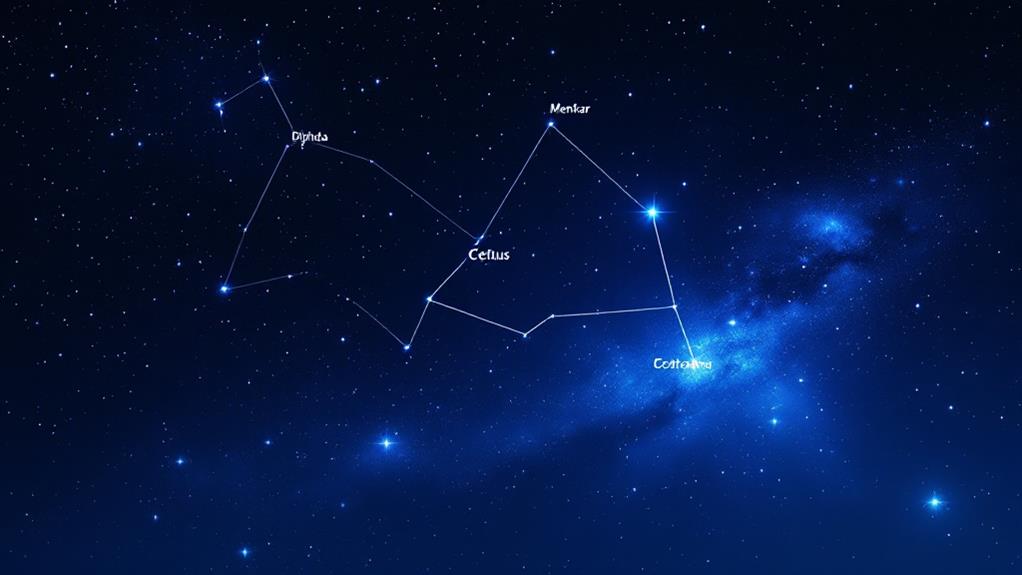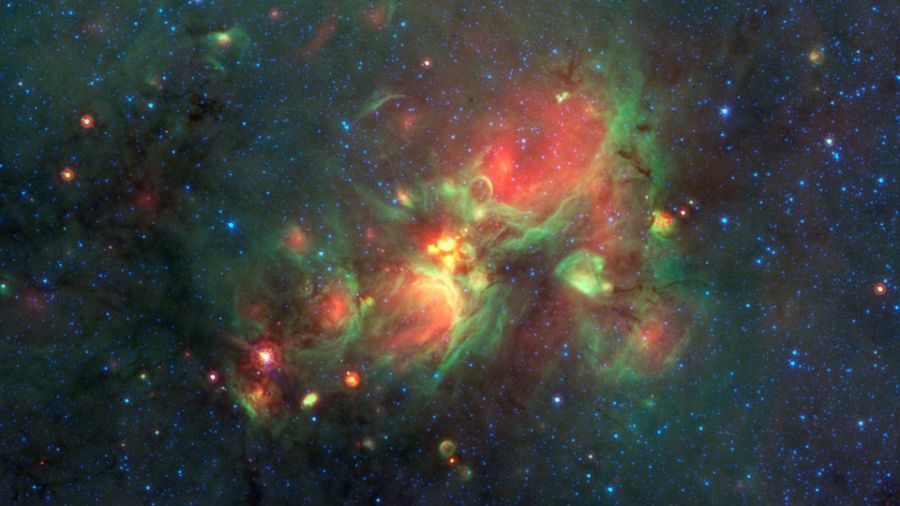How Many Stars Are in the Cetus Constellation?

The Cetus constellation contains thousands of stars, but you'll only see about 20 to 30 with your naked eye on a clear night. It's the fourth largest constellation, covering a vast area of the sky. While most visible stars are giants or supergiants, Cetus hosts a diverse array of stellar types, including hot blue stars and cooler red giants. Notable stars include Diphda, the brightest at magnitude 2.0, and Mira, a fascinating variable star. Beyond its visible stars, Cetus harbors numerous deep-sky objects like galaxies and nebulae. Exploring this celestial sea creature reveals a universe of astronomical wonders.
Defining the Cetus Constellation
When you look up at the night sky, you might spot the sprawling constellation of Cetus. This large celestial pattern, often called the Whale or Sea Monster, stretches across a significant portion of the southern hemisphere. Cetus is one of the 88 modern constellations recognized by the International Astronomical Union (IAU), with well-defined celestial boundaries that help astronomers and stargazers identify its location.
The constellation's mythological origins trace back to ancient Greek mythology, where it's associated with the story of Perseus and Andromeda. In this tale, Cetus was a sea monster sent by Poseidon to ravage the coast of Ethiopia. The constellation's shape roughly resembles a fish or whale-like creature, reflecting its aquatic mythology.
Cetus occupies a vast area of the sky, ranking fourth in size among all constellations. It's bordered by several other notable star patterns, including Aries, Pisces, and Aquarius. Despite its size, Cetus doesn't contain many bright stars, which can make it challenging to spot without dark skies or visual aids. However, its distinctive shape and mythological significance make it an intriguing target for both amateur and professional astronomers.
Visible Stars in Cetus
Cetus's star-studded expanse contains a wealth of visible celestial objects, though many aren't easily spotted with the naked eye. When you gaze at this constellation, you'll find that the number of stars visible to you depends on several factors, including your location, light pollution, and atmospheric conditions.
On a clear night in a dark area, you might be able to see around 20 to 30 stars in Cetus with your unaided vision. However, the brightness of stars varies greatly within the constellation. The brightest star in Cetus is Diphda (Beta Ceti), with a magnitude of 2.0, making it relatively easy to spot. Other notable stars include Menkar (Alpha Ceti) and Tau Ceti, which are dimmer but still visible to most observers.
It's important to note that what you can see is just a fraction of the stars actually present in Cetus. With the help of telescopes and other astronomical instruments, astronomers have identified thousands of stars within the constellation's boundaries. These include numerous faint stars, binary systems, and even distant galaxies that aren't visible to the naked eye.
Stellar Classification Within Cetus

Delving into the stellar classification within Cetus reveals a diverse array of star types. You'll find that the constellation hosts stars from various spectral classes, ranging from hot, blue O and B stars to cooler, red M-type giants. The stellar categorization in Cetus follows the Morgan-Keenan system, which considers both temperature and luminosity.
When you examine Cetus's brightest star, Deneb Kaitos (Beta Ceti), you'll uncover that it's a K0 III orange giant. This classification indicates it's cooler than our Sun and has expanded noticeably. The Orion Constellation also contains two bright supergiants - Rigel (blue-white) and Betelgeuse (red). Mira (Omicron Ceti), the famous variable star, is an M-type red giant that pulsates dramatically over time.
Luminosity evaluation plays a pivotal role in understanding Cetus's stellar population. You'll notice that many of the constellation's visible stars are giants or supergiants, which appear bright due to their immense size rather than proximity to Earth. The Big Dipper Asterism, which is part of the Ursa Major constellation, is a highly prominent and recognizable asterism. However, Cetus also contains numerous main sequence stars and white dwarfs, reflecting the diverse evolutionary stages present within this celestial whale.
Deep Sky Objects
Beyond the stars that make up its celestial outline, Cetus harbors a variety of fascinating deep sky objects. As you scrutinize this constellation, you'll encounter galaxies, nebulae, and star clusters that add depth to its cosmic tapestry.
One of the most notable deep sky objects in Cetus is the spiral galaxy M77, also known as NGC 1068. It's a Seyfert galaxy, characterized by its active galactic nucleus. You'll find it near the star Δ Ceti, shining at magnitude 8.9. The Large and Small Magellanic Clouds are also prominent objects in the southern hemisphere, appearing to the naked eye as detached parts of the Milky Way.
Cetus also contains several dark nebulae, which are clouds of dust and gas that obscure the light from stars behind them. These create striking silhouettes against the backdrop of brighter regions in the constellation.
While Cetus isn't known for its globular clusters, you can spot a few open clusters within its boundaries. NGC 246, nicknamed the Skull Nebula, is a particularly intriguing planetary nebula you won't want to miss.
As you investigate deeper into Cetus's celestial wonders, you'll uncover a rich array of galaxies, including NGC 1087, NGC 1055, and NGC 1090, each offering a unique glimpse into the universe's vast structures.
Historical Significance of Cetus

The historical significance of Cetus stretches back millennia, with its roots firmly planted in ancient mythology. You'll find this constellation deeply woven into the mythology of ancient civilizations, particularly in Greek and Mesopotamian lore. In Greek mythology, Cetus is often represented as a sea monster sent by Poseidon to ravage the kingdom of Ethiopia. It's part of the famous tale of Perseus and Andromeda, where the hero vanquishes the beast to save the princess.
The cultural significance of constellations like Cetus can't be overstated. Ancient seafarers used Cetus as a navigational guide, while farmers relied on its appearance to mark seasonal changes. In Babylonian astronomy, Cetus was associated with Tiamat, the primordial goddess of the sea. The constellation's importance extended to other cultures too, with variations of the sea monster myth appearing in Arabic, Indian, and Chinese traditions. Even today, Cetus continues to fascinate astronomers and stargazers alike, serving as a reminder of humanity's enduring fascination with the night sky and the stories we've told about it throughout history.
Observing Cetus From Earth
From Earth, observing Cetus can be a rewarding experience for amateur astronomers and stargazers alike. This large constellation is visible in both the Northern and Southern Hemispheres, making it accessible to a wide range of observers. You'll find Cetus in the night sky during autumn and winter months in the Northern Hemisphere, while it's best seen in spring and summer in the Southern Hemisphere.
To locate Cetus, look for its distinctive shape resembling a sea monster or whale. Its celestial positioning places it between Pisces and Eridanus. The constellation's brightest star, Diphda (Beta Ceti), serves as an excellent starting point for your investigations. As you scrutinize Cetus, you'll notice its vast expanse, covering nearly 1,231 square degrees of the sky.
Seasonal changes affect the visibility of Cetus throughout the year. In the Northern Hemisphere, it's most prominent from October to January. Use a star chart or smartphone app to help you identify the constellation's key features, including the variable star Mira, which undergoes dramatic brightness changes over an 11-month cycle.
Notable Stars in Cetus

Immersing into the notable stars of Cetus reveals a fascinating array of celestial bodies. You'll find Mira, also known as Omicron Ceti, a long-period variable star that's enthralled astronomers for centuries. Its brightness fluctuates dramatically over 11 months, earning it the nickname "the Wonderful." Another standout is Tau Ceti, a Sun-like star that's piqued interest due to its potential exoplanet discoveries. It's one of the closest single stars to Earth, making it a prime target for future investigation.
Beta Ceti, or Diphda, is the brightest star in the constellation. It's an orange giant that's nearing the end of its life cycle. You'll also encounter Gamma Ceti, a binary star system with intriguing variable star characteristics. The primary star is a white subgiant, while its companion is a smaller, cooler star. Zeta Ceti is worth noting for its unusual spectrum, which suggests it might be surrounded by a shell of gas. These stars, along with others in Cetus, offer a diverse range of stellar phenomena for you to scrutinize and study.
Cetus in Modern Astronomy
Modern astronomy has altered our understanding of Cetus, revealing its importance beyond ancient mythology. While celestial mythology and ancient Greek legends once shaped our perception of this constellation, today's scientists use advanced technology to study Cetus in greater detail.
You'll find that Cetus is now recognized as a treasure trove of astronomical wonders. It's home to several notable deep-sky objects, including the spiral galaxy Messier 77 and the planetary nebula NGC 246. Astronomers have also discovered exoplanets within Cetus, expanding our knowledge of planetary systems beyond our own.
The constellation's brightest star, Diphda (Beta Ceti), serves as an important reference point for astronomers studying stellar evolution. Cetus also contains Mira (Omicron Cети), the first known variable star, which continues to fascinate researchers with its regular brightness fluctuations.
Modern sky surveys have mapped thousands of stars within Cetus, far surpassing the handful visible to the naked eye. These studies contribute to our understanding of stellar populations and galactic structure. As you investigate Cetus through modern astronomy, you'll uncover a rich tapestry of cosmic phenomena that transcends its mythological origins.
Frequently Asked Questions
What Is the Best Time of Year to Observe Cetus?
You'll find the best time to observe Cetus is during the autumn and early winter months. The constellation is most visible from October through January, with November being the prime viewing month. For ideal observing conditions, look for a clear, moonless night away from city lights. You'll want to face south in the Northern Hemisphere or north in the Southern Hemisphere. Remember, Cetus is a large constellation, so you'll need a wide field of view to appreciate its full extent.
Are There Any Exoplanets Discovered in the Cetus Constellation?
You'll find several exoplanet candidates within the Cetus constellation. As you investigate this celestial sea monster, you'll observe that astronomers have identified potential exoplanets orbiting stars in this region. However, it's crucial to understand that stellar variability can sometimes mimic exoplanet signals, making confirmations challenging. Keep in mind that ongoing research and enhanced detection methods may unveil more exoplanets in Cetus, so it's an intriguing area for future discoveries in the search for distant worlds.
How Does Light Pollution Affect Visibility of Stars in Cetus?
Light pollution greatly impacts your ability to see stars in Cetus. You'll notice fewer visible stars as artificial light drowns out the night sky. This effect is particularly pronounced in urban areas. Star visibility factors include the brightness of surrounding artificial lights, atmospheric conditions, and your location's height. To best observe Cetus, you'll want to seek out dark sky areas away from city lights. Rural or raised locations will offer you the clearest views of this constellation.
What Is the Cultural Significance of Cetus in Non-Western Mythologies?
You'll find Cetus has fascinating cultural significance beyond Western mythology. In Aztec lore, you'd plunge into its association with the underworld, representing a gateway to the afterlife. If you immerse yourself in Polynesian myths, you'd encounter tales of Cetus as a fearsome sea monster, often linked to creation stories or legendary battles. These diverse interpretations showcase how ancient cultures worldwide have woven Cetus into their rich tapestries of storytelling and belief systems.
Are There Any Ongoing Research Projects Focused on Cetus?
You'll find several ongoing research projects focused on Cetus. Astronomers are continually analyzing telescope data from this constellation, searching for exoplanets, studying variable stars, and investigating its numerous galaxies. You might be interested in the efforts to map Cetus' star-forming regions or the ongoing observations of Mira, its famous pulsating star. These projects contribute to our understanding of stellar evolution, galactic structures, and the broader cosmos. Keep an eye out for exciting revelations from this celestial whale!




